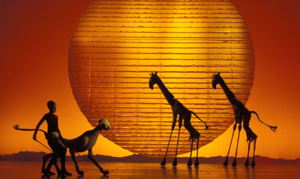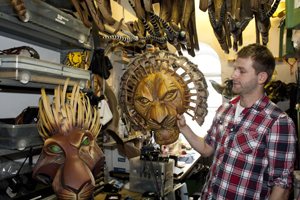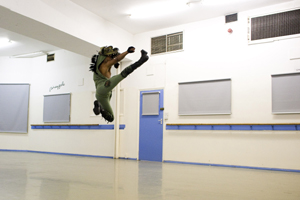The Lion King's West End Reign | reviews, news & interviews
The Lion King's West End Reign
The Lion King's West End Reign
The hit Disney musical celebrates 5,000 performances
The stage musical The Lion King has been seen by nearly 10 million people in the UK - almost 60 million worldwide – and Lord only knows how many must have seen Walt Disney’s animation. I have a friend who reckons he has seen it at least 26 times and a female acquaintance who firmly believes that curling up in front of the DVD is the cure-all for heartache – well, we can’t all write songs like Adele - but until recently, The Lion King had completely passed me by. I couldn’t even have hummed so much as a crotchet and a quaver of Elton John and Tim Rice's Oscar-winning song “Can You Feel the Love Tonight?"
 However, on a muggy night in August I found myself, arms firmly pressed against my sides, shuffling up the crowded steps into the Lyceum Theatre to catch a performance of what is one of the most commercially successful productions in theatrical history which, in addition to London, can be seen in New York, Hamburg, Tokyo, Las Vegas, is touring across North America and will open shortly in Madrid. It was the week of the London riots but that didn’t seem to be a deterrent to The Lion King audience - I couldn't see an empty seat. (Pictured above: the cheetah and giraffes during the opening sequence of The Lion King.)
However, on a muggy night in August I found myself, arms firmly pressed against my sides, shuffling up the crowded steps into the Lyceum Theatre to catch a performance of what is one of the most commercially successful productions in theatrical history which, in addition to London, can be seen in New York, Hamburg, Tokyo, Las Vegas, is touring across North America and will open shortly in Madrid. It was the week of the London riots but that didn’t seem to be a deterrent to The Lion King audience - I couldn't see an empty seat. (Pictured above: the cheetah and giraffes during the opening sequence of The Lion King.)
I’d been told that The Lion King has the most impressive opening of any stage show in London and it didn’t disappoint. Rafiki’s opening Zulu chant and the swelling of the music as an array of animals - including an 11ft high, 13ft long lumbering elephant, an actor in each leg - is summoned down the aisles to the stage is truly stirring, but what really impresses is the wit and theatrical simplicity with which Julie Taymor – who directed, wrote additional lyrics, designed the costumes and, alongside Michael Curry, the masks for the whole shebang – has reimagined the story of little Simba, who is cast out into the wilderness by his wicked uncle and must find his way home.
The Lion King opened on Broadway, New York in 1997 and the London production followed two years later, but Taymor’s early theatrical influences are a far cry from Broadway razzmatazz. She had an initial, formative experience of Asian theatre at the age of 15 during a cultural exchange programme in Sri Lanka and India and later studied mime at L’École Internationale de Théâtre Jacques Lecoq. Whilst a student at Oberlin College, Taymor joined Herbert Blau’s influential Kraken ensemble, graduating with a major in mythology and folklore and went on to form her own company, Teatre Loh, in Indonesia.
 It is this wealth of knowledge and expertise that lifts The Lion King way above the ordinary. Taymor combines African masks, where the human face can be seen, with Japanese Bunraku puppetry, which means the puppeteer is visible, and shadow puppetry to recreate the African Savannah. The audience can simultaneously see both the masks and the actors’ faces – Mufasa and Scar, two of the principal lions, have masks which can spring forward, allowing the actors to adopt a more defensive, animal form so all that is needed is a swish of the tail to complete the transformation. The giraffes are actors on stilts and the cheetah is an elongated puppet attached with wires to a performer so that it can be manipulated.
It is this wealth of knowledge and expertise that lifts The Lion King way above the ordinary. Taymor combines African masks, where the human face can be seen, with Japanese Bunraku puppetry, which means the puppeteer is visible, and shadow puppetry to recreate the African Savannah. The audience can simultaneously see both the masks and the actors’ faces – Mufasa and Scar, two of the principal lions, have masks which can spring forward, allowing the actors to adopt a more defensive, animal form so all that is needed is a swish of the tail to complete the transformation. The giraffes are actors on stilts and the cheetah is an elongated puppet attached with wires to a performer so that it can be manipulated.
Taymor refers to encouraging the audience to suspend their disbelief and fill in the blanks as “the double event”. Other ingenious effects include a field of grass rising from the stage floor to reveal a row of dancers wearing the grass as headwear and the impressive wildebeest stampede in which – and I really don’t think this needs a spoiler alert - Mufasa is killed.
But, as The Lion King approaches its 5,000th performance at the Lyceum, one of the greatest challenges that must face the 46 cast members and 106-strong production team, is how to keep the show fresh whilst making sure it appears exactly the same to the audience, whether they see the show in Hamburg or London, on a midweek matinee or a Saturday night. There has never been a change to the blueprint since the curtain rose on the very first production, although inevitably audience’s reactions are different around the world – for instance, apparently in Singapore audiences find the scene where streams of ribbon fall from the lioness’s eyes to signify tears as they grieve for Musafa absolutely hilarious.
“There isn’t really a recipe for keeping it fresh,” says Rabah Aliouane, the resident director. “We often go into the studio and have an improvisation session that’s not directly connected to the show but is related to the story or the emotion in one of the scenes or maybe we’ll decide to work on puppetry or movement – all the performers have to be very versatile, and as some are better at singing than dancing or vice versa, people are always learning and brushing up their skills. But sometimes we simply start from scratch and have a read-through. It’s a very good thing to do because you always pick up on little details that have somehow been forgotten.”
There are currently 20 different nationalities in the London show but each production of the show around the world has at least six South African performers to ensure that the Xhosa language introduced to the show by the South African composer Lebo M, which is characterised by several tongue-clicking sounds, remains authentic.
The show is recast every year but not the entire company. “Some people want to leave the show because they want to do other stuff and we respect that, but not everybody leaves, although we need to ensure that the people who do stay keep the faith and the passion to the show, because that’s the most important thing,” says Aliouane.
 Indeed, Gary Forbes (pictured right in rehearsal) has been a member of the London cast for 12 years. He was in the ensemble for two years, which meant any time he wasn't on stage during the show was spent beneath the stage in an area called “the bunker” where, along with the other 39 members of the ensemble, he managed to complete 11-12 costume changes by the end of the show. For the past 10 years, however, Forbes has played Banzai, one of the three cringing hyenas, and also understudies Mufasa, which means he has the luxury of a shared dressing room with just Andile Gumbi, who plays Simba.
Indeed, Gary Forbes (pictured right in rehearsal) has been a member of the London cast for 12 years. He was in the ensemble for two years, which meant any time he wasn't on stage during the show was spent beneath the stage in an area called “the bunker” where, along with the other 39 members of the ensemble, he managed to complete 11-12 costume changes by the end of the show. For the past 10 years, however, Forbes has played Banzai, one of the three cringing hyenas, and also understudies Mufasa, which means he has the luxury of a shared dressing room with just Andile Gumbi, who plays Simba.
However, 10 years is an awfully long time to play the same part. Long-running characters in soap operas can be fairly sure that at some point their character will take an extraordinary and highly unlikely step into unknown territory, but that’s never going to happen in The Lion King.
“There are so many different elements to the hyenas – the singing, acting, dancing, puppetry - that you never get stale," insists Forbes, "and also there are three of us and we are interacting with each other all the time. We all come into the theatre with different moods every day and we can use that to our advantage.
“I treat every performance as if it’s my first – there are people who have saved up for a long time to see the show so I owe it to them to do my best and anyway, as an actor you’re only as good as your last performance, so I want to keep getting better and better. Just to get into this show was an honour – to still be in it 12 years later is an even greater honour.”
But however good the performances – and there are some excellent ones – it is Taymor’s glorious staging that is the jewel in The Lion King’s crown.
- The 5000th performance of The Lion King will take place on 13 September at the Lyceum Theatre
 Book tickets for The Lion King at the Lyceum Theatre, London WC2 until 1 April, 2012
Book tickets for The Lion King at the Lyceum Theatre, London WC2 until 1 April, 2012 Find The Lion King on Amazon
Find The Lion King on Amazon
more Theatre
 Banging Denmark, Finborough Theatre review - lively but confusing comedy of modern manners
Superb cast deliver Van Badham's anti-incel barbs and feminist wit with gusto
Banging Denmark, Finborough Theatre review - lively but confusing comedy of modern manners
Superb cast deliver Van Badham's anti-incel barbs and feminist wit with gusto
 London Tide, National Theatre review - haunting moody river blues
New play-with-songs version of Dickens’s 'Our Mutual Friend' is a panoramic Victori-noir
London Tide, National Theatre review - haunting moody river blues
New play-with-songs version of Dickens’s 'Our Mutual Friend' is a panoramic Victori-noir
 Machinal, The Old Vic review - note-perfect pity and terror
Sophie Treadwell's 1928 hard hitter gets full musical and choreographic treatment
Machinal, The Old Vic review - note-perfect pity and terror
Sophie Treadwell's 1928 hard hitter gets full musical and choreographic treatment
 An Actor Convalescing in Devon, Hampstead Theatre review - old school actor tells old school stories
Fact emerges skilfully repackaged as fiction in an affecting solo show by Richard Nelson
An Actor Convalescing in Devon, Hampstead Theatre review - old school actor tells old school stories
Fact emerges skilfully repackaged as fiction in an affecting solo show by Richard Nelson
 The Comeuppance, Almeida Theatre review - remembering high-school high jinks
Latest from American penman Branden Jacobs-Jenkins is less than the sum of its parts
The Comeuppance, Almeida Theatre review - remembering high-school high jinks
Latest from American penman Branden Jacobs-Jenkins is less than the sum of its parts
 Richard, My Richard, Theatre Royal Bury St Edmund's review - too much history, not enough drama
Philippa Gregory’s first play tries to exonerate Richard III, with mixed results
Richard, My Richard, Theatre Royal Bury St Edmund's review - too much history, not enough drama
Philippa Gregory’s first play tries to exonerate Richard III, with mixed results
 Player Kings, Noel Coward Theatre review - inventive showcase for a peerless theatrical knight
Ian McKellen's Falstaff thrives in Robert Icke's entertaining remix of the Henry IV plays
Player Kings, Noel Coward Theatre review - inventive showcase for a peerless theatrical knight
Ian McKellen's Falstaff thrives in Robert Icke's entertaining remix of the Henry IV plays
 Cassie and the Lights, Southwark Playhouse review - powerful, affecting, beautifully acted tale of three sisters in care
Heart-rending chronicle of difficult, damaged lives that refuses to provide glib answers
Cassie and the Lights, Southwark Playhouse review - powerful, affecting, beautifully acted tale of three sisters in care
Heart-rending chronicle of difficult, damaged lives that refuses to provide glib answers
 Gunter, Royal Court review - jolly tale of witchcraft and misogyny
A five-women team spell out a feminist message with humour and strong singing
Gunter, Royal Court review - jolly tale of witchcraft and misogyny
A five-women team spell out a feminist message with humour and strong singing
 First Person: actor Paul Jesson on survival, strength, and the healing potential of art
Olivier Award-winner explains how Richard Nelson came to write a solo play for him
First Person: actor Paul Jesson on survival, strength, and the healing potential of art
Olivier Award-winner explains how Richard Nelson came to write a solo play for him
 Underdog: the Other, Other Brontë, National Theatre review - enjoyably comic if caricatured sibling rivalry
Gemma Whelan discovers a mean streak under Charlotte's respectable bonnet
Underdog: the Other, Other Brontë, National Theatre review - enjoyably comic if caricatured sibling rivalry
Gemma Whelan discovers a mean streak under Charlotte's respectable bonnet
 Long Day's Journey Into Night, Wyndham's Theatre review - O'Neill masterwork is once again driven by its Mary
Patricia Clarkson powers the latest iteration of this great, grievous American drama
Long Day's Journey Into Night, Wyndham's Theatre review - O'Neill masterwork is once again driven by its Mary
Patricia Clarkson powers the latest iteration of this great, grievous American drama

Add comment